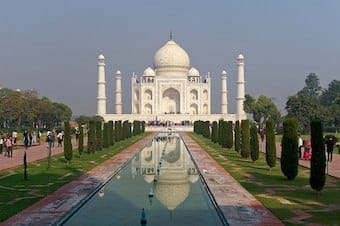The Taj Mahal (‘Crown of the Palace’), the mausoleum built in 1632-1653 by Shah Jahan (r. 1628-58) for his second and favourite wife, Arjumand Banu Begum (1593-1631), known as Mumtaz Mahal or ‘Exalted One of the Palace’. Shah Jahan (1592-1666) was also buried here. Craik set the Taj in historical context for English readers, mentioning the English Civil War (1642-1651), the reign of Charles II (1649-1685) and the Great Fire of London (1666) which destroyed old St Paul’s Cathedral — new St Paul’s was built in 1675-1710. Craik found India’s civilisation unexpectedly modern. “Throughout the scenes amongst which I have passed,” he wrote, “one hardly ever recalls history more distant than the days of Milton.”
Introduction
In 1907, Sir Henry Craik MP went on a tour of India. That December, he made his way south from New Delhi to Agra, where he marvelled at the sixteenth-century fort and the Pearl Mosque of Shah Jahan (r. 1628-58) before following the River Yamuna for a mile or so towards Shah Jahan’s legendary monument to his favourite wife, Mumtaz Mahal. Would it be all that report had made it?
SLOWLY the miracle of Agra, the Taj, opens on our view — at first a white dome, encircled by dazzling minarets, and then slowly showing its surroundings of portal and mosque, contrasting with its snowy brilliancy and simplicity in their deep warm red, and in the fantastic and rich ornamentation of their facades and parapets. The Taj rises above them, vast and majestic, in its perfect simplicity of outline, solid, and yet seeming at times almost to melt into cloud and sky. We pass through two courtyards of red stone, bordered with serais,* and on through its richly decorated portal of red, chequered with variegated marbles, into the long peaceful garden with its rows of Italian cypresses, its trim flower beds,* its marble paths, and its pools and fountains, at the far end of which rises, above marble staircase and platform, the vast mass of pure white outlining itself against the deep blue of the sky. All doubts, all fears of disappointed expectations, all feelings except that of over-mastering beauty, are swept away; and each step, as we come nearer to it, and it gradually dwarfs the foliage that lies below, confirms the magic of its unrivalled grace. By this alone, one is tempted to think, the voyage to India would be repaid. [...]
* By the end of the Mughal era, in the early nineteenth century, the condition of the gardens had declined; but in Victoria’s later years, the British relaid them, somewhat favouring the formal London fashions of the day.
* ‘Serai’ is a Turkish word (reflecting the influence of the Ottoman Empire on India) meaning a guesthouse.
Précis
On a trip to India in 1907, Sir Henry Craik called at Agra to see the Taj Mahal. He was nervous that after all he had heard, the monument might prove an anticlimax; but the cool white marble of the Taj, the warm red sandstone gateways, the formal gardens and the playing fountains quite took his breath away. (58 / 60 words)
On a trip to India in 1907, Sir Henry Craik called at Agra to see the Taj Mahal. He was nervous that after all he had heard, the monument might prove an anticlimax; but the cool white marble of the Taj, the warm red sandstone gateways, the formal gardens and the playing fountains quite took his breath away.
Variations: 1.increase the length of this precis to exactly 65 words. 2.reduce the length of this precis to exactly 55 words. 3.introduce one of the following words into the precis: about, because, despite, must, not, since, until, whereas.
Word Games
Jigsaws Based on this passage
Express the ideas below in a single sentence, using different words as much as possible. Do not be satisfied with the first answer you think of; think of several, and choose the best.
Post Box : Help Available
You are welcome to share your creativity with me, or ask for help with any of the exercises on Clay Lane. Write to me at this address:
See more at Post Box.
If you like what I’m doing here on Clay Lane, from time to time you could buy me a coffee.
Buy Me a Coffee is a crowdfunding website, used by over a million people. It is designed to help content creators like me make a living from their work. ‘Buy Me a Coffee’ prides itself on its security, and there is no need to register.


